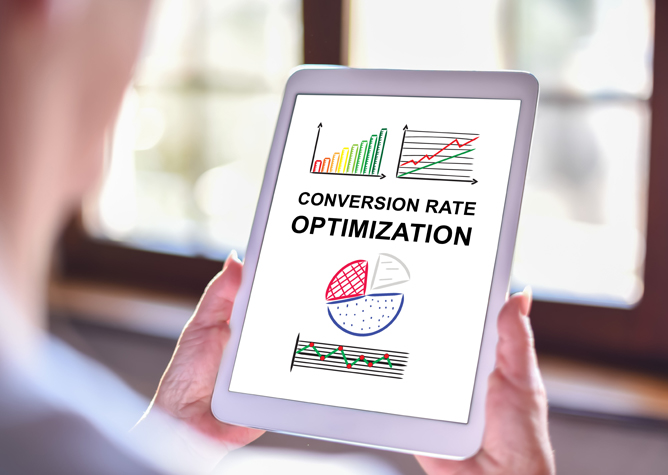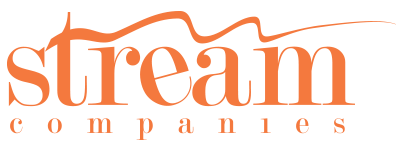Increasing conversions without increasing ad spending.
Web traffic means more visibility for your brand. When that traffic is made up of interested consumers, more meaningful engagement—in other words, conversion—is likely.
Whether your goal is to get web visitors to sign up for a newsletter or make a purchase, Stream Companies’ conversion rate optimization (CRO) program helps make your goals a reality.
How to calculate conversion rate
Conversion rates are calculated by taking the total number of conversions over a given time period and dividing it by the total number of visitors during the same time. Here’s a visual of the formula:
Let’s say the conversion point you were looking at was the point of purchase. If you earned 25 sales from your website over the course of a month, and your website saw 500 visitors, you’d be looking at a conversion rate of 5%.
How can you increase rates without increasing the budget? Well, it takes a dedicated driving force to deliver the best user experience.
What should my conversion rate be? Look beyond the industry average.
The short answer is: it depends. Average conversion rates tend to be between 1% and 4%, but that’s quite a broad rule of thumb and may not be a useful metric for your case. Many factors play into what your conversion rate is, including:
- Your conversion goal. Conversion rates differ based on the conversion you are measuring. It could be ad clicks, completed purchases, or even signups for a newsletter. You shouldn’t expect to see consistency across goals.
- Your industry. The audience for each industry is different. Not surprisingly, this causes the conversion process to play out differently depending on the industry you serve.
- Your website and web pages. We’re not just talking about differences in quality, which obviously influence conversion rates. Different designs and types of content—some industry-exclusive—factor in as well.
In other words, knowing the “average” conversion rate may not prove useful for your success in CRO. It’s certainly useful to know your specific conversion rates so you have a benchmark from which to improve. But trying to maintain or exceed an industry average is likely to lead you to focus on the wrong things.
As we’ll discuss in a moment, CRO is better approached with a mindset of giving your users what matters to them, not just trying to “hit your numbers”. Take the first route, and more conversions are sure to follow!
What is conversion rate optimization?
Conversion rate optimization, or CRO, is just what it sounds like: optimizing the rate of conversion, or the percentage of users who perform a desired action, on your website. Those actions may include but are not limited to:
- Clicking a link
- Filling out a form
- Purchasing a product
- Clicking “add to cart”
- Signing up for a service
Each of these actions is a significant step in the user’s movement through the buyer’s journey. While the ultimate goal is to compel prospects to purchase a product or sign up for a service, key conversion moments like clicking a link or filling out a form can be crucial steps in that journey.
If you can make more of these conversions happen without increasing your ad spend, you’ve struck gold in your journey to build a more intuitive and relevant shopping process for users!
CRO from the user’s point of view
The usual definitions of CRO—like the one we wrote above—emphasize the cold, hard numbers. And while it’s important to know conversion percentages as well as other benchmarks, there may be a better place to anchor your CRO strategy.
When you look at spreadsheet after spreadsheet of conversion data points and actions, you spend less time thinking about the people—your potential customers—behind those actions. Do you understand what they want from a website experience?
And that leads us to what is, perhaps, a more useful way to understand CRO: It’s understanding what drives, stops, and persuades visitors to your website so you can improve the user experience for them.
Focusing too much on conversions can lead to a kind of tunnel vision where you forget about the experiences leading up to the conversions. And that’s a shame because those experiences are where all the action is. You must evaluate them honestly if you want to improve conversion rates.
CRO: The journey behind the data
When you choose an agency for CRO services, you should be looking for a team that understands not every problem is quantifiable. Sure, sometimes there’s an obvious bug in the system that is keeping customers from converting. But more often than not, the problem and solution aren’t defined by hard numbers.
When your website is working perfectly and people still aren’t converting, it’s your job—and your agency’s job—to delve into the why behind it.
Focus on your users first. That means you need to understand the story behind their experiences on your website—the journey behind the data.
How to evaluate user experience
Here are some specific points you’ll want to consider:
- What drives people to your website in the first place.
- What stops your users from proceeding—what drives them away.
- What persuades users to stay on the site and act.
There’s more work to be done after you’ve identified your motivators, barriers, and hooks. Knowing what drives people to your website is just half the battle. Are you creating content and facilitating experiences that speak to that drive—to their unique journey?
One of the biggest mistakes digital marketers make is simply failing to answer the user’s questions. This starts from the moment the user sees that meta description in your PPC ad or organic content and continues as they make the transition from search engine to your website.
If you can’t answer their questions, you’re not speaking to their drive. And here’s our question: Why would they bother converting if you don’t do that?
Speaking to your users’ drive at every step
At every step along the way to that conversion, you must compel users to follow along.
Start with your paid search ads. Don’t waste time repeating the search query but instead answer the question behind the search query. You’ll need to ponder the motivations of your users in order to do so.
Consider, too, where your users are in the shopper’s funnel and how committed they are. If they’re in the earliest stages, they may not be ready to download an eBook to learn more about your product or service. To return to our terminology above, that eBook might act as a barrier to engagement at this point in the process.
A website experience that avoids barriers
Here’s another way to think about what your website should be doing at its best: giving users the answers they’re looking for without increasing friction rates.
If there’s friction, users will bounce. You’ll lose prospects that could have been receptive to your message if it had been presented in a different way. Worse yet, high bounce rates will cause Google to knock you down a peg or two (or more!) on search engine results pages (SERPs), making it even harder for users to find you in the first place.
One way to reduce friction and provide answers that meet your users where they are? We recommend using chat bots to answer questions about your services or products in real time. This has a few benefits:
- Allows the user to choose to engage. (They’re coming to you.)
- Answers the user’s exact (Your website content and paid search ads can only answer a “best guess” at the user’s question.)
- Shows personal interest in the needs of a unique customer.
- Shows company expertise in the industry/specialty.
Best of all, chat bots lower the rate of friction and the risk of bouncing by providing answers without needed action. The user won’t feel trapped into taking an action they’re not quite ready for, especially early on in their knowledge-gathering process.
A good hook can be replicated
Finally, pay attention to the hooks that persuade your users to stay and convert.
Remember, these hooks are more than just the call-to-action (CTA) buttons and forms that users click and fill out to complete a conversion. They’re elements of your site that keep users on the page at every twist and turn until a conversion is made.
Anything they see that snags and holds their interest is a hook. And anything that doesn’t hold their interest has the potential to be a hook if reworked.
Defining a hook like that can be a game changer. After all, it’s a definition that encompasses every on-page element on your site. It forces you to think about users’ engagement with your entire web presence from start to finish.
Your website’s hooks include:
- CTA buttons, including their colors, messaging, and placement
- Relevant and well-designed landing pages
- Website aesthetics and copy
- Above-the-fold content
To create an engaging user experience, no concept may be quite as important as above-the-fold content. This is the content positioned in the upper half of a web page, so it can be seen by users without having to scroll down the page.
Your most dynamic, eye-catching visuals, attention-grabbing headlines, and important calls-to-action should appear above the fold! Most users will not take the time to scroll through an entire piece of content from top to bottom. You want to place your hooks where the fish are.
As you’re out there angling for conversions, remember that a good hook can be used again. CTA language that has been shown to convert—whether in style or content—can be incorporated into your brand and replicated throughout your website.
5 best practices for conversion rate optimization
In CRO, as in many specialties, best practices are fluid and constantly evolving. What worked for others in the past won’t necessarily work for you in the future.
However, one constant factor of success in this field is understanding the scientific method. As you experiment with different landing pages and other site elements, you’ll want to keep these practices in mind:
1) Go beyond just A/B testing
A/B testing occurs when two variants of a page, form, CTA button, etc., are tested against each other to see which one performs better. You can use these tests for virtually any element on your website that you’re looking to improve—and marketers do exactly that.
While A/B testing is necessary, it’s not enough. Sure, it’s important to know which version of the experiment performed better. But it doesn’t tell you why a version performed better, and that’s the insight you need to improve user experience.
To gather that insight, you’ll need to do some qualitative analysis and put yourself in the user’s shoes.
2) Define your goals rigorously
Well-defined goals are essential for experiments. You’ll need this cornerstone of the scientific process if you want clarity in what you are measuring and accurate and actionable results—which of course, we all do!
Your goals should be directly related to the experiment to establish a clear causal link between the variables you’re measuring and the goal. For instance, if you are optimizing a landing page with a form, your goal should be immediately related to that. It might be increasing the number of form submissions, but not something further down the line and less clearly connected, like increasing sales.
Some experiments may have more than one goal. In fact, secondary goals can be quite useful to check that your experiment had no unintended negative effects.
For instance, let’s say the changes you made to the design of the form increased form submissions (a good thing!) but also resulted in lower-quality submissions (not so good). If that were the case, you would want to know, wouldn’t you?
That insight would show you that your solution was not the optimal fix for the problem at hand, giving you permission to continue to tinker with it and test.
3) Define your hypothesis, too
Your goals may be clear, but you need a clear hypothesis, too, so you know exactly what you are testing. Again, this will help you tie your experiment more closely to your goals. A workable hypothesis will:
- Identify the problem.
- Propose a solution that you think will fix the problem.
- Identify a metric you can use to judge the success of the experiment.
4) Don’t make changes mid-experiment
When you see a change that needs to be made while you’re running an experiment, the impulse is to make that change immediately! We understand that. In fact, we recommend it, especially if the problem is hurting your conversion efforts.
However, you should never stop, edit, and restart your experiment with the change in place. This will corrupt your carefully collected data. Changes large and small can impact user behavior on your website in a really big way.
There’s a better way forward: Stop the current experiment and make the change. Then, make a copy of the experiment with the necessary change in place from the beginning. This way, you won’t introduce an unintended variable to the equation.
5) Remember there are no rules, just guidelines
Yes, this is an article on best practices in CRO reminding you that there are no best practices in CRO! Or at least, best practices are conditional.
All best practices (beyond adhering to the scientific method when you’re doing actual science!) are methods that have worked in the past, in certain cases. That does not mean they’ll continue to work in the future—or for you.
Common tips range from using a strong color for CTA buttons and placing CTA buttons above the fold to using time-limited offers and urgency to drive conversions. They may work for you. But then again, they may not.
The best way to drive a successful CRO strategy, if we haven’t said it enough, is to take time to understand your users and customers. Every time, this approach wins out over chasing metrics with canned tactics.
So, here’s what you need to do:
- Watch how people use your website
- Listen to what they say about your website
- Talk to the people who designed your website and your products/services
- Talk to your sales and support teams
- Evaluate and integrate all this feedback
Think about it. Your support teams know what issues people commonly come to them with—perhaps after unsuccessfully searching your website for answers.
The people who designed your products and services know their unique selling points—and your website designer knows the ins and outs of UX and UI and how changes to your website may play themselves out.
The people who use your website are among your most invaluable sources of information—and watching how they use it can tell you things even they wouldn’t think to say.
In short, successful CRO comes down to getting feedback from everyone involved in the user experience. It depends on making the connections needed to improve that experience and generate more conversions. An agency that can balance the qualitative and quantitative aspects of CRO is well placed to help you succeed!
Boost conversion rates on your website
Most consumers these days are shopping online. For this reason, your website is one of the biggest hubs for new leads and brand representation. You want your website to look great, but beyond that, it needs to be optimized to drive the buyer to act.
Our first CRO goal is always to get you more leads. Our secondary goal is to perform a systematic redesign of your website and messaging to deliver quality leads: Leads that convert!
For that CRO program to be successful, it’s important to define what success means. Are you trying to increase sales or get more month-over-month eBook downloads, for instance? We’ll work with you to identify objectives and key performance indicators so we can decide how success will be measured.
Putting
Hypotheses to the Test
It takes a well-rounded toolkit to deliver a well-rounded CRO strategy. Google Analytics, heat maps, and other data are studied by our team of SEO specialists to determine if there are possible areas of improvement on your website. Our expert hypotheses are then put through A/B testing.
A/B testing allows us to split traffic coming to your website. Half of the visitors will see one version of the website, while half will see another version. After this testing, we study the data to determine which version captures more leads. Through this tried-and-true process, your brand can expect:
- Increased profits
- Better customers
- Improved ROI for all marketing channels
Score proven CRO results for your business
Stop randomly throwing darts to increase sales and conversion rates. The team at Stream Companies offers proven ways to increase profits and attract new customers, scoring bullseyes time and again.
We are based outside of Philadelphia, in the Malvern, PA, area. Reach out today to discover what our CRO services can do for your business.



